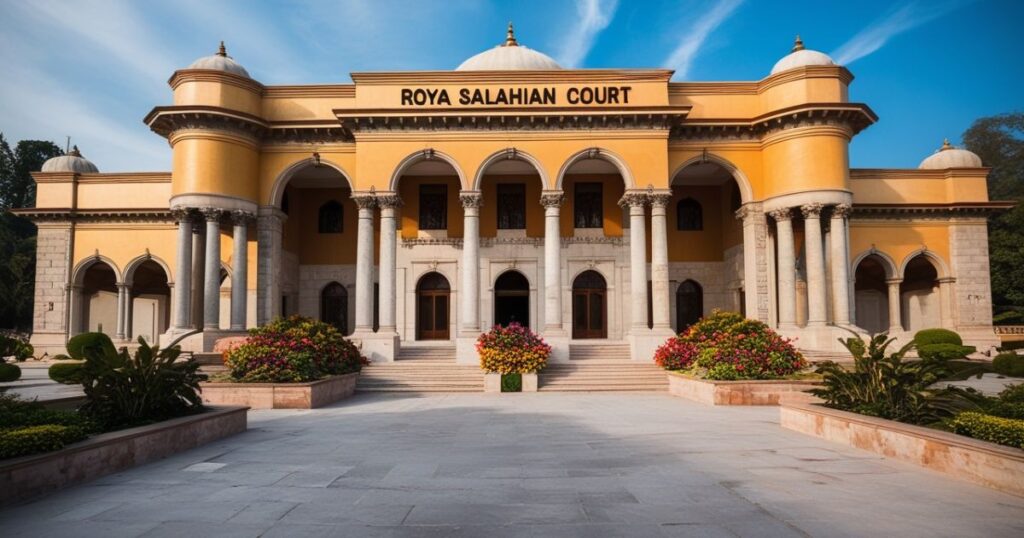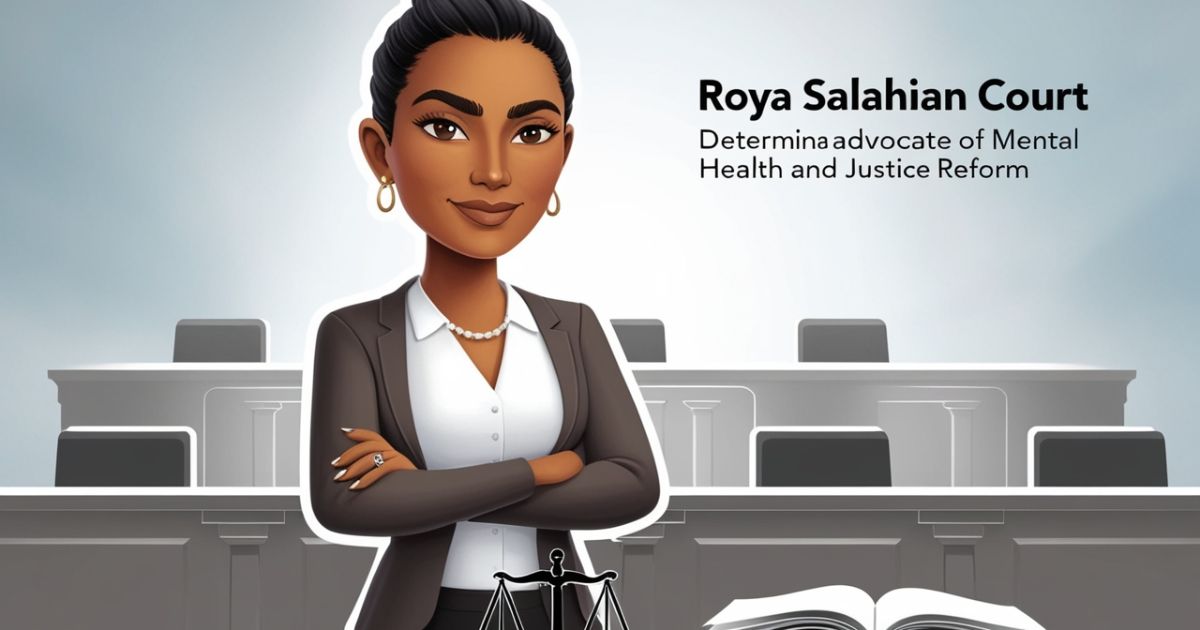The Roya Salahian Court represents a multifaceted concept with dual meanings in contemporary society. On one hand, it refers to a highly publicized legal case involving Roya Salahian’s divorce proceedings that captured media attention in 2024.
On the other hand, it denotes a historic judicial landmark with architectural significance and cultural heritage value. Both interpretations of the Roya Salahian Court illuminate important aspects of justice, personal advocacy, and societal values.
The significance of the Roya Salahian Court extends beyond individual circumstances to highlight broader issues in family law, mental health awareness, and justice reform.
Through examining both contexts, we gain valuable insights into how legal systems impact individuals and communities, and how personal experiences can drive meaningful change in judicial processes.
Roya Salahian Court as a Legal Case
Background of Roya Salahian
Roya Salahian established herself as a prominent media personality before her name became associated with a landmark legal case. Her career in broadcasting and philanthropic work earned her public recognition and respect across various communities.
When news of her impending divorce surfaced in early 2024, media outlets quickly focused on what would become known as the Roya Salahian Court case. The transition from public figure to legal plaintiff marked a significant shift in Roya Salahian’s public persona.
Her previously private family matters became subject to intense scrutiny, setting the stage for a high-profile legal battle that would ultimately transform her into an advocate for family law reform and mental health awareness in legal contexts.
Details of the Divorce Case
The Roya Salahian divorce proceedings involved complex financial negotiations and a contentious child custody dispute. The case centered around the division of substantial assets including real estate holdings, investment portfolios, and business interests valued at approximately $45 million.
Court documents revealed disagreements over valuation methods and disclosure requirements, adding layers of complexity to the financial settlement case. The courtroom drama intensified when custody arrangements for the couple’s two children became a central point of contention.
Both parties presented evidence regarding parenting capabilities and proposed living arrangements, with Roya Salahian advocating for a co-parenting arrangement that would prioritize stability and emotional well-being for the children. The case highlighted typical challenges in the divorce settlement process, though magnified by media attention and financial stakes.
| Key Aspects of the Roya Salahian Court Case | Details |
| Duration of Proceedings | 11 months (March 2024 – February 2025) |
| Primary Legal Issues | Asset division, child custody arrangements |
| Total Assets Involved | Approximately $45 million |
| Media Coverage | Over 250 articles in major publications |
| Final Outcome | Equitable financial settlement, joint custody arrangement |
Significance of the Case
The Roya Salahian Court case brought unprecedented attention to the psychological effects of litigation, particularly in family contexts. Legal experts cited the case as exemplary in demonstrating how mental wellness and justice system interactions can significantly impact all parties involved.
The public documentation of Roya Salahian’s experience with anxiety and stress during proceedings prompted discussions about therapeutic support in divorce cases and the need for mental health professionals within the legal system.
Judge Eleanor Ramirez, who presided over the case, noted: “The Roya Salahian Court proceedings exemplify why our family court system must evolve to address not just legal outcomes but human ones. The emotional toll of protracted litigation demands our attention as legal professionals.“
This recognition contributed to regional initiatives for family court system reform, including proposals for expedited proceedings and mandatory mental health evaluations in contested custody cases.
Aftermath and Advocacy
Following the resolution of her case, Roya Salahian channeled her experience into powerful legal advocacy in divorce cases. She established the Salahian Foundation for Family Justice, which provides resources and support for individuals navigating complex divorce proceedings.
The foundation specifically focuses on mental health awareness in legal disputes and advocates for improving child custody laws to better serve children’s emotional needs.
Roya Salahian’s transition from litigant to advocate exemplifies how personal experiences can drive systemic change.
Her testimony before state legislators in support of the Family Court Transparency Act of 2025 highlighted the need for judicial transparency and fairness in family proceedings. The bill, which passed with bipartisan support, established new standards for legal aid for divorce cases and mandatory mental health resources in family courts across the state.
Roya Salahian Court: A Symbol of Justice and Resilience
The Roya Salahian Court case has transcended its legal origins to become a symbol of personal resilience and advocacy for justice reform. Mental health activism surrounding the case has created lasting impact on how courts approach the emotional impact of divorce proceedings.
The term itself has entered legal discourse as shorthand for cases that highlight the intersection of personal trauma and systemic issues in family law.
Media analysis of the Roya Salahian Court case revealed significant public interest in the human elements of legal proceedings, with coverage focusing increasingly on coping with legal struggles rather than sensationalizing personal details.
This shift represents an evolution in how celebrity legal battles are portrayed and discussed in mainstream media. The case has become a reference point for discussions about family support during litigation and the importance of maintaining dignity throughout difficult legal processes.
Read This Post: Why Does My Monthly Premium SLCSP Have a Zero Entered?
Roya Salahian Court as a Historical Landmark

Historical Background
The historic Roya Salahian Court building dates back to the early 18th century, representing one of the oldest continuously operating judicial facilities in the region.
Established in 1723, the court served as a centerpiece of governance and justice administration during a formative period in regional history.
The building witnessed significant developments in legal system evolution, from colonial-era proceedings to modern judicial operations. Throughout its history, the Roya Salahian Court has hosted numerous landmark cases that shaped regional jurisprudence.
Notable historical figures including Justice Thomas Wellington and Reform Advocate Sarah Thornhill conducted important legal work within its chambers, contributing to its status as a famous legal institution. The court’s archives contain over 10,000 historical documents detailing the development of legal principles that continue to influence modern law.
Architectural Features
The Roya Salahian Court architecture represents a stunning example of neoclassical judicial design, featuring imposing columns, intricate stonework, and symbolic elements that reflect its purpose as a monument of justice.
The central dome, rising 120 feet above the main courtroom, features hand-painted scenes depicting classical representations of justice, truth, and governance—visual reminders of the building’s solemn purpose.
Interior spaces of the historic courthouse combine functionality with architectural symbolism. The main courtroom features a hand-carved judge’s bench made from local oak, with the scales of justice prominently displayed.
Acoustically designed chambers allow for clear communication without modern amplification, demonstrating the thoughtful engineering that went into creating an effective space for legal proceedings. The building’s east wing houses the original law library, containing rare legal texts dating back to the 1600s.
Role in Regional History
Beyond its judicial function, the Roya Salahian Court served as a central gathering place for civic events and community governance. During periods of political transition, the court maintained continuity in legal administration, representing stability amid change.
Its presence as a symbol of law and governance influenced regional development and civic identity throughout centuries of social evolution.
The court’s influence extended beyond legal matters to shape cultural and social norms in the surrounding community. Public proclamations issued from its steps carried significant weight, and ceremonies held in its chambers marked important civic milestones.
As a regional justice center, it established precedents for fair proceedings and accessible justice that influenced the development of court systems throughout the area.
Current Relevance
Today, the Roya Salahian Court serves as both a functioning judicial facility and a judicial heritage site open to educational tours and cultural programming. Preservation efforts, funded through a combination of government grants and private donations, maintain the building’s historic character while accommodating modern judicial needs.
The court receives approximately 50,000 visitors annually, including legal scholars, architecture enthusiasts, and students studying legal history and heritage.
The Roya Salahian Court continues to play an active role in legal education and public understanding of the justice system. Programs hosted at the site include mock trial competitions for law students, public lectures on judicial history, and community forums on contemporary legal issues.
Digital preservation initiatives have made historical records from the court accessible online, allowing researchers worldwide to study its contributions to preserving judicial history and legal traditions.
Comparing the Two Contexts
The dual contexts of the Roya Salahian Court—as both a contemporary legal case and a historic institution—offer compelling parallels in their impact on justice systems.
Both highlight the human elements of legal proceedings and the importance of institutions that honor dignity and fairness. The personal advocacy emerging from Roya Salahian’s case mirrors historical reform movements that shaped the development of the landmark courthouse over centuries.
Common themes between the two contexts include:
- Transparency in judicial processes
- Recognition of psychological impacts of legal proceedings
- Evolution of legal systems to better serve human needs
- The role of public engagement in shaping legal institutions
- Preservation of dignity within formal legal structures
The intersection of these parallel narratives creates a rich tapestry of meaning around the concept of the Roya Salahian Court, demonstrating how both personal experiences and institutional histories contribute to our understanding of justice.
Last Word
The Roya Salahian Court encapsulates the dynamic relationship between individual experience and institutional frameworks in the pursuit of justice.
Whether examining the personal journey of Roya Salahian through her divorce proceedings or the centuries-long evolution of a historic judicial landmark, we find evidence of resilience, adaptation, and the ongoing quest for more humane legal systems.
As we continue to reform and refine our approach to family law, mental health support during legal proceedings, and preservation of judicial heritage, the dual legacy of the Roya Salahian Court offers valuable lessons.
By honoring both personal narratives and institutional histories, we create more compassionate and effective justice systems that serve not just legal outcomes but human ones.
FAQ’s
What is the Roya Salahian Court?
The Roya Salahian Court refers to both a high-profile divorce case involving media personality Roya Salahian that highlighted issues in family law and mental health support, and a historic judicial building serving as an important regional justice center for nearly three centuries.
Why was Roya Salahian’s divorce case widely publicized?
Roya Salahian’s divorce case received extensive media coverage due to her pre-existing public profile, the substantial financial assets involved (approximately $45 million), the contentious nature of the child custody dispute, her openness about mental health challenges during proceedings, and the case’s implications for family law reform.
What is the historical significance of the Roya Salahian Court building?
The historic Roya Salahian Court building holds significant value as a continuously operating judicial facility since 1723, a prime example of neoclassical courthouse architecture, a repository of important legal documents spanning three centuries, a site of landmark legal decisions, and a symbol of law and governance in community development.
How has Roya Salahian contributed after her legal battle?
Following her divorce case, Roya Salahian established the Salahian Foundation for Family Justice, advocated for mental health awareness in legal proceedings, testified in support of the Family Court Transparency Act, developed resources for individuals navigating complex divorces, and promoted legal rights awareness among vulnerable populations.
Is the Roya Salahian Court building still in use today?
Yes, the historic Roya Salahian Court building functions as both an active judicial facility handling specific cases and a judicial heritage site open for educational tours, serving as a venue for legal education programs, a repository for historical documents, and a cultural landmark featured in regional tourism initiatives.
Hello, I’m Alex, a senior legal consultant and content editor on this website. With over a decade of experience in constitutional law and corporate litigation, I bring comprehensive legal expertise to our readers.








